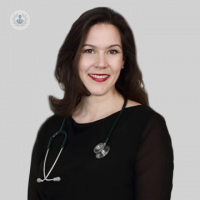Defining osteoporosis
Escrito por:Osteoporosis’ associated symptoms, particularly resulting fractures from just a fall or even bending over, are significantly distressing for those who have it.
Top Doctors speaks to highly-experienced general practitioner Dr Victoria Owen about the condition in this detailed and informative article. She considers how osteoporosis assessed and diagnosed, among other essential points such as age groups and people most affected, as well as how it’s treated.

How is osteoporosis defined?
Osteoporosis is a low bone mineral density with bone strength that is compromised and poor structure within the bones.
These factors predispose a person to an increased risk of fracture. The bone structure weakens, and this causes bones to easily fracture with minimal trauma.
It’s a medical condition that been recorded throughout history, and can be seen in Egyptian remains from 1000BC.
At what point are bones the strongest?
Bone strength increases from birth to age 30, and from the age of 45 both men and women begin to lose a percentage of bone every year.
Who does osteoporosis affect?
It can occur in both men and women. It’s more common in women and is more likely to begin at a younger age in women.
This is due to differences in bone density and muscle mass in men and women:
- Women have a lower peak bone density
- Women have less muscle mass
- Women also reach the fracture threshold sooner because there’s an accelerated rate of bone loss after menopause.
Osteoporosis becomes a problem as people age, and it's exemplified in the statistics; that there are currently 5 million osteoporotic fractures every year in the UK.
How is osteoporosis assessed?
A bone density scan (DEXA), which assesses bone thickness. It takes a measurement at the hip and lower back. In special circumstances, the wrist is used. A DEXA is non-invasive and doesn’t hurt.
Two readings are taken; one is called the T-score. This compares the bone density result to that of a healthy person aged 30. The other is called the Z score, which compares the results to those of a healthy person’s bone density of a similar age.
How is osteoporosis diagnosed?
Osteoporosis is diagnosed, either via:
- A fracture not due to trauma (fall from a standing position), or;
- Assessment:
- We use a T score for men over 50 and women after menopause.
- We use a Z score for men under 50 and women before menopause.
The point where osteoporosis is diagnosed is a T score of -2.5. Osteoporosis identifies the thinnest 30 per cent of bones in the population.
The T score level was chosen by a group of specialists in 1984, because there’s evidence that 30 per cent of people have an osteoporotic fracture in their lifetime. Doctors are working to identify the people who will experience this.
What is osteopenia, and is it a useful term?
Osteopenia is the term used when bones begin to thin but the person is not in the bottom 30 per cent. A better term for this is ‘low bone density’.
We see how quickly how patients are losing bone mass by monitoring them over time. The progression of bone loss is:
Normal, to osteopenia, to osteoporosis.
Who should be screened for osteoporosis and when?
All women that are 65 years should be screened, and post-menopausal women of a younger age, too, if they show signs of osteoporosis such as:
- Low weight;
- Prior fractures;
- Take high-risk medications like steroids, or;
- Have diseases which accelerate bone loss like rheumatoid arthritis.
Men who are aged 70 should be screened, and should be screened earlier if there has been a prior fracture or have been prescribed high-risk medications such as steroids.
What is involved in the decision to screen for osteoporosis at an earlier age?
A FRAX score is used. It asks a lot of questions and provides a risk level.
The FRAX score helps in telling us if a patient is likely to:
- Be fine;
- Needs to start treatment;
- Need a DEXA scan to for further information.
Once treatment has begun, FRAX is not reliable and it can only be used for patients that are over 40 years old.
Once a patient has been DEXA screened, when should it be repeated?
Repeating a DEXA screening depends on the findings at your first scan. They should be at least a year apart. It’s been shown that the time it takes to develop osteoporosis depends on the results of your first scan.
Osteoporosis will develop in fewer than 10 per cent of postmenopausal women and this can be used to decide on the management.
Rates for 10 per cent of patients developing osteoporosis:
- 15 years for a woman with normal bone density;
- Five years for a woman with moderate osteopenia;
- One year of a woman with advanced osteopenia.
Your doctor will advise you when your next scan is required.
How is osteoporosis treated?
If a woman has other symptoms of menopause, HRT can be used especially in those between 50 and 59 years. Bone quality is maintained through this therapy.
There are 23/1000 less fractures for women on HRT.
Bone strength is helped by biphosphates such as Alendronic acid, which is a tablet taken either weekly or monthly. It can be taken for five years and then reassessed.
It should be noted that HRT leads to higher bone density, and better-quality bone than alendronate. However, HRT bone density decreases when you stop HRT, while alendronic acid therapy has ongoing benefits.
More severe cases, or patients who are intolerant of biphosphates, are prescribed denosumab.
Aside from medication, what can I do to strengthen my bones?
Lifestyle changes such as the following can help:
- Exercise
- Taking calcium and Vitamin D
- Stopping smoking
- Reducing intake of alcohol
If you want to receive expert osteoporosis care, arrange an appointment with London GP Dr Owen via her Top Doctors profile.


